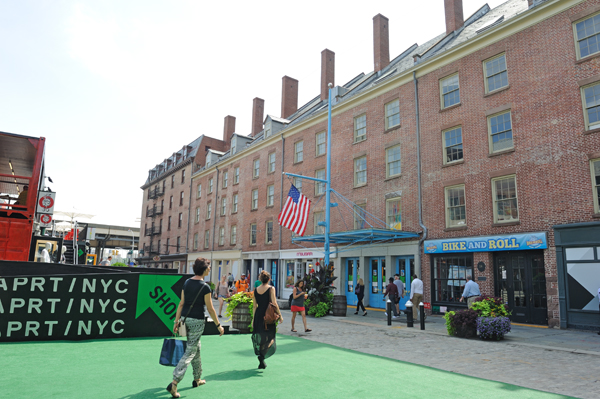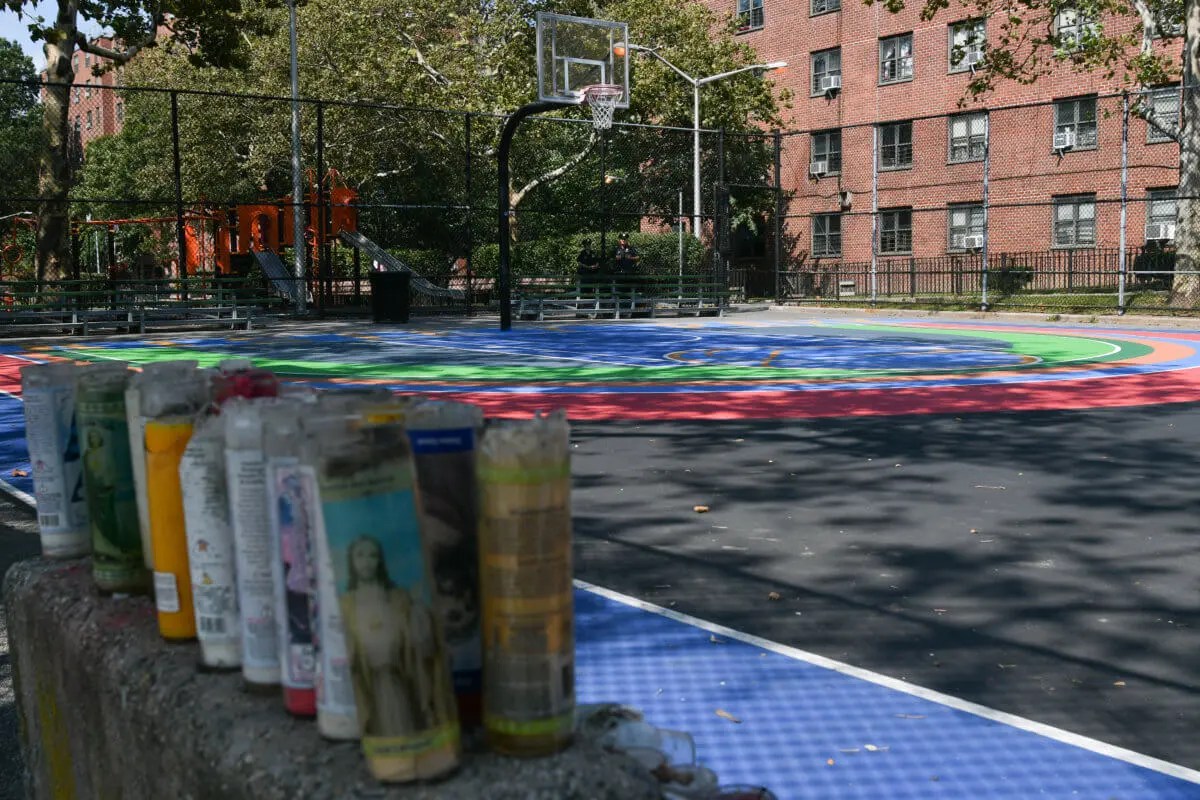
ORIGINALLY PUBLISHED SEPT. 5, 2013 | BY TERESE LOEB KREUZER | The Howard Hughes Corporation, a developer based in Dallas, Texas, has privately submitted plans to transform the South Street Seaport.
An indication of the Hughes vision for the Seaport can presently be seen on Fulton St. between Water and South Sts. and on Front St. between Fulton and Beekman where the company has installed picnic tables and shipping containers that house food stalls and food retailers. Artificial grass covers a swath of Fulton St.’s cobblestones, serving as a staging area for free movies and music performances.
The Howard Hughes Corporation submitted its development plans for the Seaport to its landlord, the New York City Economic Development Corporation on Aug. 31, as it was required to do by the terms of a letter of intent signed by both parties in December 2011, an E.D.C. spokesperson said Sept. 4, but she declined to say what was in those plans or when they would be made public.
Spokespersons for the Hughes firm have not responded to requests for comment.
The letter of intent says that Hughes reserved for itself the option to erect a first-class hotel, market-rate residential apartments and additional retail space in the Seaport.
Matthew Viggiano, land use and planning director for Councilmember Margaret Chin in whose City Council district the Seaport lies, said that he had contacted the E.D.C. for information about the newly filed plans but had not received a response.
“We don’t know anything more at 5:30 on Sept. 3 than we did at 5:30 on Aug. 30th,” he said last week. “If we get these documents, we’ll ask that they be made available to the community board and to the [City] Council office. Once they’re there, those are public documents.”
Even the city’s Dept. of Cultural Affairs, which has taken the lead in trying to keep the South Street Seaport Museum afloat, has not seen Hughes’ plans to redevelop the area, Danai Pointer, the agency’s spokesperson, said last week.
What is known at the moment is that on June 27, 2013 Andrew Schwartz, first deputy commissioner for the New York City Department of Small Business Services (S.B.S.) and Grant Herlitz, president of Hughes Corp. and of its subsidiaries, South Street Seaport Limited Partnership and Seaport Marketplace, signed two documents apparently giving Hughes a stronger hold on additional Seaport properties.
These documents came to light because of the efforts of the Save Our Seaport group, an association of South Street Seaport residents, businesses and individuals that is trying to preserve the Seaport from commercial development that they say would destroy its historic character.
The Memorandum of Lease signed on June 27, reflecting an amended and restated Agreement of Lease, also signed on June 27, says that The Howard Hughes Corporation has “the right and option to lease all or any part of the first (ground) and second stories of buildings on the Museum Block and space located on the ground floor of the Schermerhorn Block and known as Nos. 12 and 14 Fulton Street.”
Twelve Fulton has been occupied by the South Street Seaport Museum, which used it for exhibitions until it was forced to close those galleries on April 7, because essential climate control and other systems had been badly damaged by Superstorm Sandy with insufficient money forthcoming for repairs.
The museum maintained that E.D.C., as its landlord, should have fixed these base building systems, which also included escalators and elevators. Had E.D.C. done so, FEMA would have reimbursed the outlay — but E.D.C. said it wasn’t responsible.
The museum shop was formerly located at 14 Fulton St. in a space that is still under the museum’s control.
The memorandum goes on to say that Howard Hughes has the right to space located above the second story of buildings on the Museum Block, the landmarked Tin Building on South Street and all portions of the Schermerhorn Block except existing public circulation areas within 12 Fulton St.
In addition, this document gives Hughes the right of first offer to purchase or lease a lot located on the southeast corner of John St. and South St. When the museum’s electrical system was damaged, one proposal to restore the museum to viability was to use that John St. lot to erect a small building in which the electrical system could be housed, safely above the possibility of future flood damage.
In its cover pages listing the properties subsumed by the Memorandum of Lease, Pier 16 is mentioned. This pier is currently under the jurisdiction of the museum and is used to berth its historic ships.
Kate Blumm, an E.D.C. spokesperson, said that these options and allocations to Howard Hughes are nothing new. According to Blumm, 12 and 14 Fulton St. are mentioned in a lease signed with the Rouse Company on Dec. 15, 1981 and in the amended lease signed this year with its successor, The Howard Hughes Corporation on June 27.
“The John St. lot is also included in the original lease,” said Blumm. “The right of first offer on the John St. lot was acquired through a separate agreement executed under different circumstances.”
The second document signed on June 27 is entitled “Improvement Agreement Termination.”
The Improvement Agreement Termination seems to confirm in writing what had been true as a matter of practice since the Giuliani administration, namely that the holder of the Seaport marketplace leases (now Howard Hughes) had no financial obligation to the museum.
Hughes and its subsidiary Seaport Marketplace, L.L.C., were successors to General Growth Properties, which went bankrupt. General Growth was, in turn, the successor to the Rouse Company, which originally held the leases pertinent to the South Street Seaport. One provision of those original leases called for Rouse to funnel money from its commercial activities in the Seaport to the South Street Seaport Museum to help support it.
That funding never happened, and the museum has consequently struggled financially for most of the time since it was founded in 1967.
Community Board 1’s Seaport Committee had been hopeful, even adamant, that Howard Hughes help to finance the Seaport Museum in exchange for its opportunity to earn significant revenue in the Seaport. Hughes had been paying its landlord, the E.D.C., $3.50 a square foot for the space it rents on Pier 17, for instance. When the new shopping mall is finished in a few years, that space should be rentable for several hundred dollars per square foot.
Under a new leasing agreement with the City, Howard Hughes will be paying a flat rent of $1.2 million a year, not based on square footage.
But Blumm said that new lease makes Hughes solely responsible for maintaining Pier 17 and its substructure and the portions of the East River esplanade that run through Hughes’ leasehold. In addition, Hughes will contribute $210,000 a year for use on the East River esplanade wherever that money is needed.
Blumm claims that this arrangement will save the city millions of dollars over the life of its lease, which could, at Hughes’ option, extend through Dec. 30, 2072.
The Howard Hughes Corporation has engaged RKF, a realty company, to help it lease its South Street Seaport properties. A glossy brochure prepared to abet that process entitled “See/Change historic South Street Seaport” shows the museum’s properties as being among those available for lease by Howard Hughes.
This is “an earlier marketing plan presented by the Howard Hughes Corporation which inadvertently included buildings that are not a part of the leasing plans. It has since been corrected,” said E.D.C. spokesperson Patrick Muncie in an email on Aug. 27.
Based on information that has surfaced since then, the “See/Change” document may not have been totally incorrect, just somewhat premature. Blumm said she would provide a corrected version of that leasing document, but did not do so.





























